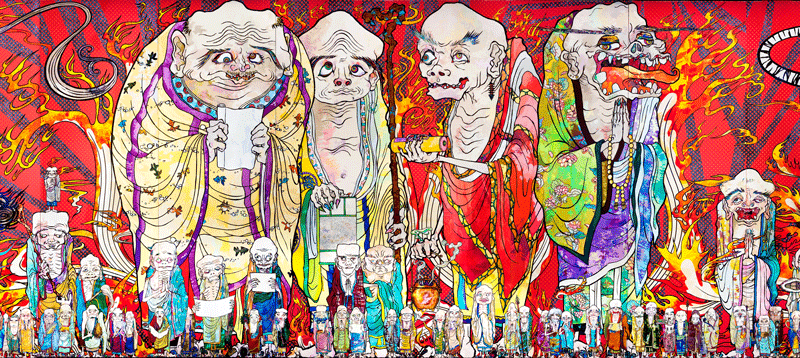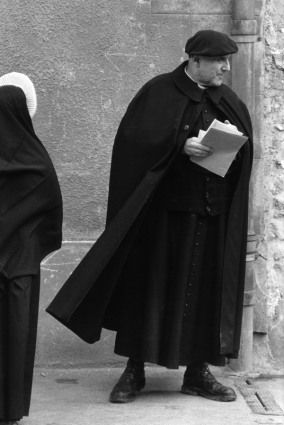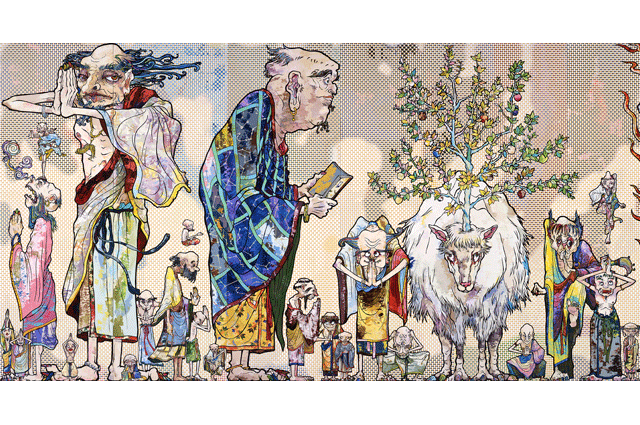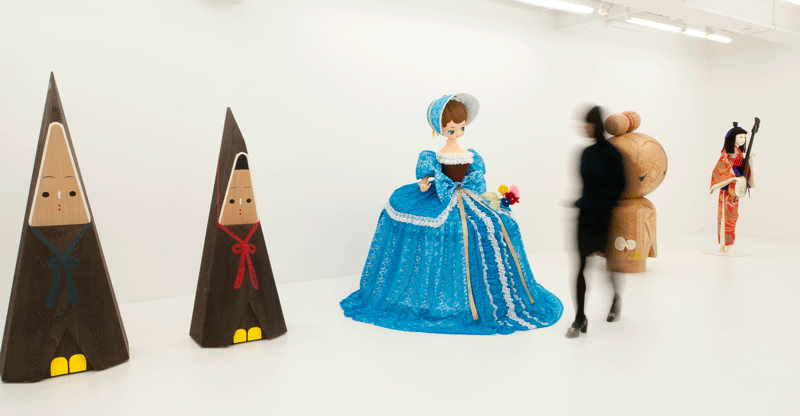What meaning do we ascribe to an artist’s work based on his or her reputation? How are we influenced by titles and names? This month’s exhibitions take a new look at well-known artists, offering us a chance to see their art in a new light, and to see them for who they are, as people.
By Sarah Custen
“Takashi Murakami: The 500 Arhats”
Hailed as Takashi Murakami’s magnum opus, “The 500 Arhats” is a massive undertaking, both in scale and intention. An internationally-minded and acclaimed artist, Murakami has exhibited his works to an astounded global audience and now brings us a highly-anticipated solo exhibition in Japan, with his remarkable 100-meter-long masterpiece.
Born and raised in Tokyo, Murakami became the first ever recipient of a PhD in Nihonga (Japanese-style paintings) from Tokyo University of the Arts’ School of Fine Arts. He’s best known for being the father of “Superflat,” a post-modern art movement informed by manga, anime, otaku culture and Japanese art history. His canvases are eye-poppingly vibrant, saturated with color, imbued with creepy cartoonishness and cultural symbolism.

Takashi Murakami, The 500 Arhats (detail), 2012, Acrylic on canvas, mounted on board, 302 x 10,000 cm, Private collection, © 2012 Takashi Murakami/Kaikai Kiki Co., Ltd. All Rights Reserved.
Murakami created “The 500 Arhats” as a token of gratitude to Qatar, in recognition of their timely response efforts and aid following the Great East Earthquake and Tsunami of 2011. Inspired by Edo-period paintings and conversations with art historian Tsuji Nobuo, Murakami enlisted the help of some 200 art students from Japanese colleges to complete the work, which is divided into four sections, each bearing the name of one of four Chinese guardians of the celestial directions. This collaborative effort touches on themes of religion, human mortality, gratitude and interconnectedness.
Mori Art Museum
Dates: October 31, 2015–March 6, 2016
Open: Daily 10:00–22:00, Tuesdays until 17:00
Web: www.mori.art.museum/eng/index.html
“Masato Nakamura: Luminous Despair”
The photographic work, in the context of contemporary art, throws light on movements and ideas which arose in art history after World War II, says Masato Nakamura, the artist and founder behind 3331 Arts Chiyoda. “The photos capture actions and artworks arising on streets … creativity of individuals synchronizes with the creative power of the city.”
Even in the joyous pictures – parties, projects, performances – there is a subtle sadness. “Our passions and actions became so intense in the era of collapse of the bubble economy [at the end of the 20th century], and also the era of transition from analog to digital,” Nakamura explained. These images are a documentation of that transition.
Nakamura attempts to synchronize, visually, the creative, artistic and cultural aspects of Korea, where he started off as a fledgling artist, with those of Japan. “When we look close, we can find evidence in everyday life that Japan and Korea are culturally, politically, and economically linked,” he said. “I try to visualize this through art. I want the viewer to feel this connection between two countries and be aware that we are geologically placed in one frame, despite the history of bitter conflict.”
In a larger context, the exhibition is about changing the way Japan relates to the rest of the world, and to itself, through art. “Asians cannot be the winners in the context of art history or a modern art world that is dominated by western countries,” he said “We must find an alternative way to weave an art history of our own.”
3331 Arts Chiyoda
Dates: October 10–November 23, 2015
Open: Open daily, 11:00–20:00
Web: www.3331.jp/schedule/en/002988.html
“Yozo Hamaguchi and Shotaro Akiyama: 4 Months in Paris”

Shotaro Akiyama, “At street corner,” From “Four months in Paris” (1960), Gelatin silver print, Shotaro Akiyama Photographic Art Museum
Active throughout the latter half of the 20th century, Japanese photographer Shotaro Akiyama was most admired for his commercial portraiture, though his true passion was floral photography, work which failed to gain popular acceptance in his lifetime. “4 Months in Paris” chronicles Akiyama’s sojourn in France and time spent with Yozo Hamaguchi at the Venice Biennale. The trip drained Akiyama’s financial resources but left him forever changed. “Before this trip, photography is just his business—he’s just a photographer,” explained Naoko Kambayashi, Chief Curator for Musée Hamaguchi Yozo. “But after…he became an artist.”
Yozo Hamaguchi was Akiyama’s contemporary and mentor. A decade senior and more traveled, he served as a source of inspiration and guidance. Born in 1909 in Wakayama, the third son of Yamasa Shoyu’s tenth president, Hamaguchi was able to forego the family business in favor of art. He spent years abroad in France and the US, and is most famous for his use of “mezzotint,” a developing technique for color-plate printing. The true achievement of this simple yet stunning exhibition is its subtlety. Shotaro Akiyama’s seemingly casual snapshots of people and places in 1960s Italy and France draw you in: the angle and definition of forms, richness of tones, and variety of textures hold your gaze captive, offering up a sweet, slow decay of years gone by, grainy and soft. Hamaguchi’s mezzotints, conversely, are heavy, precise, distinguished. The combination of the two is fascinating. “It’s dark, and it’s brilliant,” said Kambayashi.
Musée Hamaguchi Yozo
Dates: October 10, 2015–January 24, 2016
Open: Tuesday through Friday, 11:00–17:00, Saturday and Sundays from 10:00
Web: www.yamasa.com/musee/en/
Main Image: Takashi Murakami, The 500 Arhats (detail), 2012, Acrylic on canvas, mounted on board, 302 x 10,000 cm, Private collection, © 2012 Takashi Murakami/Kaikai Kiki Co., Ltd. All Rights Reserved.










